Jinze Li
NLGCL: Naturally Existing Neighbor Layers Graph Contrastive Learning for Recommendation
Jul 10, 2025Abstract:Graph Neural Networks (GNNs) are widely used in collaborative filtering to capture high-order user-item relationships. To address the data sparsity problem in recommendation systems, Graph Contrastive Learning (GCL) has emerged as a promising paradigm that maximizes mutual information between contrastive views. However, existing GCL methods rely on augmentation techniques that introduce semantically irrelevant noise and incur significant computational and storage costs, limiting effectiveness and efficiency. To overcome these challenges, we propose NLGCL, a novel contrastive learning framework that leverages naturally contrastive views between neighbor layers within GNNs. By treating each node and its neighbors in the next layer as positive pairs, and other nodes as negatives, NLGCL avoids augmentation-based noise while preserving semantic relevance. This paradigm eliminates costly view construction and storage, making it computationally efficient and practical for real-world scenarios. Extensive experiments on four public datasets demonstrate that NLGCL outperforms state-of-the-art baselines in effectiveness and efficiency.
RealFactBench: A Benchmark for Evaluating Large Language Models in Real-World Fact-Checking
Jun 14, 2025Abstract:Large Language Models (LLMs) hold significant potential for advancing fact-checking by leveraging their capabilities in reasoning, evidence retrieval, and explanation generation. However, existing benchmarks fail to comprehensively evaluate LLMs and Multimodal Large Language Models (MLLMs) in realistic misinformation scenarios. To bridge this gap, we introduce RealFactBench, a comprehensive benchmark designed to assess the fact-checking capabilities of LLMs and MLLMs across diverse real-world tasks, including Knowledge Validation, Rumor Detection, and Event Verification. RealFactBench consists of 6K high-quality claims drawn from authoritative sources, encompassing multimodal content and diverse domains. Our evaluation framework further introduces the Unknown Rate (UnR) metric, enabling a more nuanced assessment of models' ability to handle uncertainty and balance between over-conservatism and over-confidence. Extensive experiments on 7 representative LLMs and 4 MLLMs reveal their limitations in real-world fact-checking and offer valuable insights for further research. RealFactBench is publicly available at https://github.com/kalendsyang/RealFactBench.git.
MDVT: Enhancing Multimodal Recommendation with Model-Agnostic Multimodal-Driven Virtual Triplets
May 22, 2025Abstract:The data sparsity problem significantly hinders the performance of recommender systems, as traditional models rely on limited historical interactions to learn user preferences and item properties. While incorporating multimodal information can explicitly represent these preferences and properties, existing works often use it only as side information, failing to fully leverage its potential. In this paper, we propose MDVT, a model-agnostic approach that constructs multimodal-driven virtual triplets to provide valuable supervision signals, effectively mitigating the data sparsity problem in multimodal recommendation systems. To ensure high-quality virtual triplets, we introduce three tailored warm-up threshold strategies: static, dynamic, and hybrid. The static warm-up threshold strategy exhaustively searches for the optimal number of warm-up epochs but is time-consuming and computationally intensive. The dynamic warm-up threshold strategy adjusts the warm-up period based on loss trends, improving efficiency but potentially missing optimal performance. The hybrid strategy combines both, using the dynamic strategy to find the approximate optimal number of warm-up epochs and then refining it with the static strategy in a narrow hyper-parameter space. Once the warm-up threshold is satisfied, the virtual triplets are used for joint model optimization by our enhanced pair-wise loss function without causing significant gradient skew. Extensive experiments on multiple real-world datasets demonstrate that integrating MDVT into advanced multimodal recommendation models effectively alleviates the data sparsity problem and improves recommendation performance, particularly in sparse data scenarios.
Gumiho: A Hybrid Architecture to Prioritize Early Tokens in Speculative Decoding
Mar 13, 2025Abstract:Speculative decoding (SPD) aims to accelerate the auto-regressive token generation process of a target Large Language Model (LLM). Some approaches employ a draft model with multiple heads to predict a sequence of future tokens, where each head handles a token in the sequence. The target LLM verifies the predicted sequence and accepts aligned tokens, enabling efficient multi-token generation. However, existing methods assume that all tokens within a sequence are equally important, employing identical head structures and relying on a single-generation paradigm, either serial or parallel. To this end, we theoretically demonstrate that initial tokens in the draft sequence are more important than later ones. Building on this insight, we propose Gumiho, a hybrid model combining serial and parallel heads. Specifically, given the critical importance of early tokens, we employ a sophisticated Transformer architecture for the early draft heads in a serial configuration to improve accuracy. For later tokens, we utilize multiple lightweight MLP heads operating in parallel to enhance efficiency. By allocating more advanced model structures and longer running times to the early heads, Gumiho achieves improved overall performance. The experimental results demonstrate that our method outperforms existing approaches, fully validating its effectiveness.
Jakiro: Boosting Speculative Decoding with Decoupled Multi-Head via MoE
Feb 10, 2025Abstract:Speculative decoding (SD) accelerates large language model inference by using a smaller draft model to predict multiple tokens, which are then verified in parallel by the larger target model. However, the limited capacity of the draft model often necessitates tree-based sampling to improve prediction accuracy, where multiple candidates are generated at each step. We identify a key limitation in this approach: the candidates at the same step are derived from the same representation, limiting diversity and reducing overall effectiveness. To address this, we propose Jakiro, leveraging Mixture of Experts (MoE), where independent experts generate diverse predictions, effectively decoupling correlations among candidates. Furthermore, we introduce a hybrid inference strategy, combining autoregressive decoding for initial tokens with parallel decoding for subsequent stages, and enhance the latter with contrastive mechanism in features to improve accuracy. Our method significantly boosts prediction accuracy and achieves higher inference speedups. Extensive experiments across diverse models validate the effectiveness and robustness of our approach, establishing a new SOTA in speculative decoding. Our codes are available at https://github.com/haiduo/Jakiro.
AlignGroup: Learning and Aligning Group Consensus with Member Preferences for Group Recommendation
Sep 04, 2024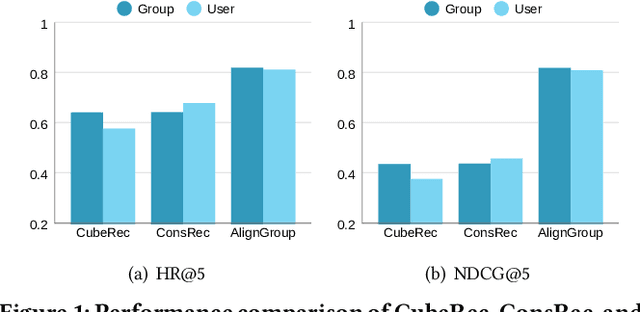

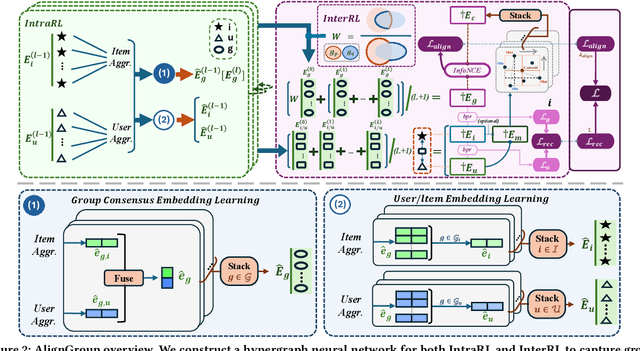

Abstract:Group activities are important behaviors in human society, providing personalized recommendations for groups is referred to as the group recommendation task. Existing methods can usually be categorized into two strategies to infer group preferences: 1) determining group preferences by aggregating members' personalized preferences, and 2) inferring group consensus by capturing group members' coherent decisions after common compromises. However, the former would suffer from the lack of group-level considerations, and the latter overlooks the fine-grained preferences of individual users. To this end, we propose a novel group recommendation method AlignGroup, which focuses on both group consensus and individual preferences of group members to infer the group decision-making. Specifically, AlignGroup explores group consensus through a well-designed hypergraph neural network that efficiently learns intra- and inter-group relationships. Moreover, AlignGroup innovatively utilizes a self-supervised alignment task to capture fine-grained group decision-making by aligning the group consensus with members' common preferences. Extensive experiments on two real-world datasets validate that our AlignGroup outperforms the state-of-the-art on both the group recommendation task and the user recommendation task, as well as outperforms the efficiency of most baselines.
FourierKAN-GCF: Fourier Kolmogorov-Arnold Network -- An Effective and Efficient Feature Transformation for Graph Collaborative Filtering
Jun 04, 2024
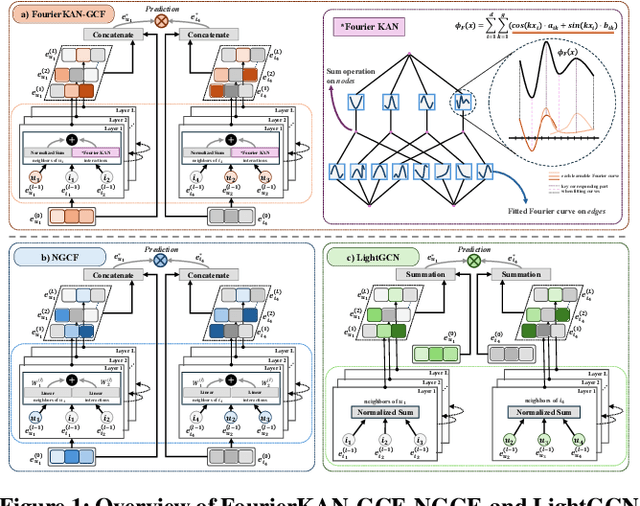
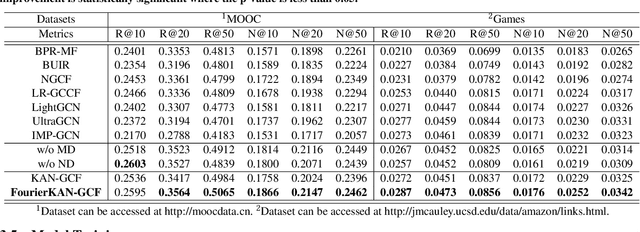
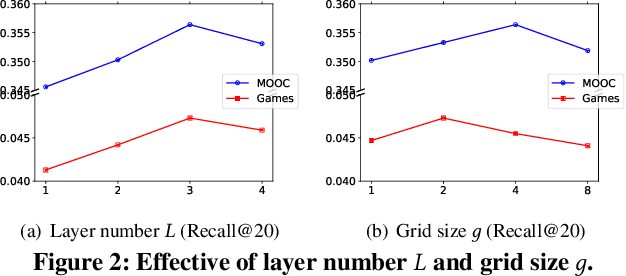
Abstract:Graph Collaborative Filtering (GCF) has achieved state-of-the-art performance for recommendation tasks. However, most GCF structures simplify the feature transformation and nonlinear operation during message passing in the graph convolution network (GCN). We revisit these two components and discover that a part of feature transformation and nonlinear operation during message passing in GCN can improve the representation of GCF, but increase the difficulty of training. In this work, we propose a simple and effective graph-based recommendation model called FourierKAN-GCF. Specifically, it utilizes a novel Fourier Kolmogorov-Arnold Network (KAN) to replace the multilayer perceptron (MLP) as a part of the feature transformation during message passing in GCN, which improves the representation power of GCF and is easy to train. We further employ message dropout and node dropout strategies to improve the representation power and robustness of the model. Extensive experiments on two public datasets demonstrate the superiority of FourierKAN-GCF over most state-of-the-art methods. The implementation code is available at https://github.com/Jinfeng-Xu/FKAN-GCF.
MENTOR: Multi-level Self-supervised Learning for Multimodal Recommendation
Feb 29, 2024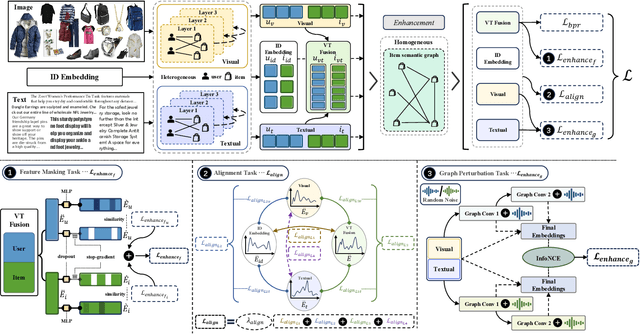

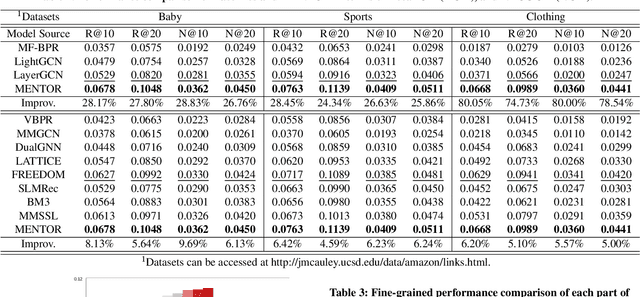
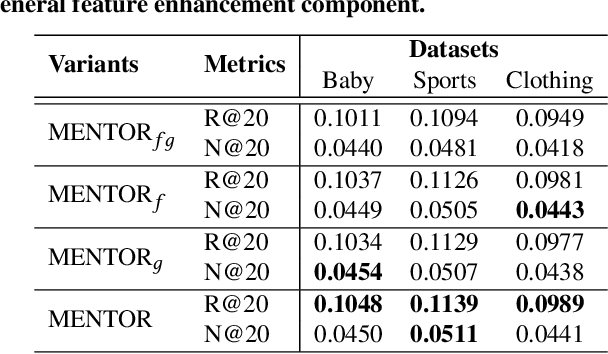
Abstract:With the increasing multimedia information, multimodal recommendation has received extensive attention. It utilizes multimodal information to alleviate the data sparsity problem in recommendation systems, thus improving recommendation accuracy. However, the reliance on labeled data severely limits the performance of multimodal recommendation models. Recently, self-supervised learning has been used in multimodal recommendations to mitigate the label sparsity problem. Nevertheless, the state-of-the-art methods cannot avoid the modality noise when aligning multimodal information due to the large differences in the distributions of different modalities. To this end, we propose a Multi-level sElf-supervised learNing for mulTimOdal Recommendation (MENTOR) method to address the label sparsity problem and the modality alignment problem. Specifically, MENTOR first enhances the specific features of each modality using the graph convolutional network (GCN) and fuses the visual and textual modalities. It then enhances the item representation via the item semantic graph for all modalities, including the fused modality. Then, it introduces two multilevel self-supervised tasks: the multilevel cross-modal alignment task and the general feature enhancement task. The multilevel cross-modal alignment task aligns each modality under the guidance of the ID embedding from multiple levels while maintaining the historical interaction information. The general feature enhancement task enhances the general feature from both the graph and feature perspectives to improve the robustness of our model. Extensive experiments on three publicly available datasets demonstrate the effectiveness of our method. Our code is publicly available at https://github.com/Jinfeng-Xu/MENTOR.
Memory-Based Label-Text Tuning for Few-Shot Class-Incremental Learning
Jul 03, 2022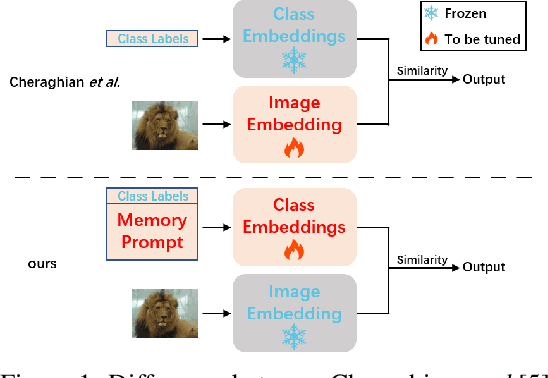

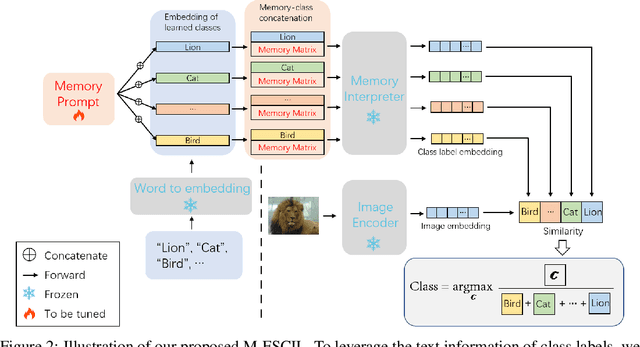

Abstract:Few-shot class-incremental learning(FSCIL) focuses on designing learning algorithms that can continually learn a sequence of new tasks from a few samples without forgetting old ones. The difficulties are that training on a sequence of limited data from new tasks leads to severe overfitting issues and causes the well-known catastrophic forgetting problem. Existing researches mainly utilize the image information, such as storing the image knowledge of previous tasks or limiting classifiers updating. However, they ignore analyzing the informative and less noisy text information of class labels. In this work, we propose leveraging the label-text information by adopting the memory prompt. The memory prompt can learn new data sequentially, and meanwhile store the previous knowledge. Furthermore, to optimize the memory prompt without undermining the stored knowledge, we propose a stimulation-based training strategy. It optimizes the memory prompt depending on the image embedding stimulation, which is the distribution of the image embedding elements. Experiments show that our proposed method outperforms all prior state-of-the-art approaches, significantly mitigating the catastrophic forgetting and overfitting problems.
Distance-IoU Loss: Faster and Better Learning for Bounding Box Regression
Nov 19, 2019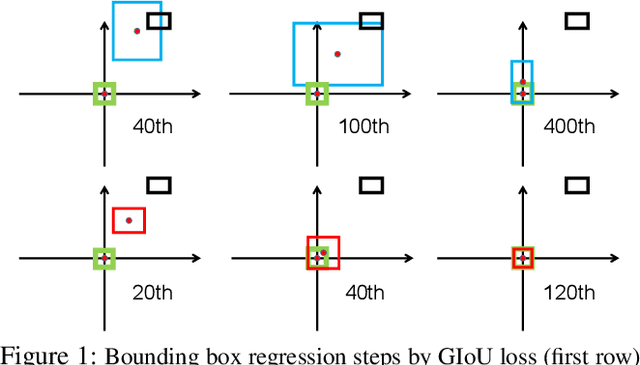
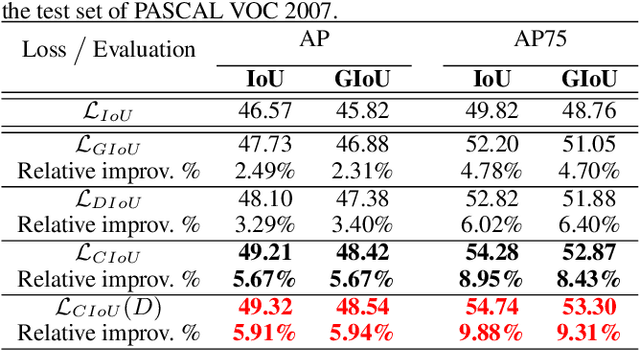
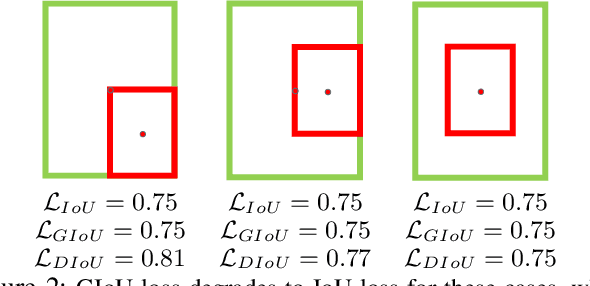
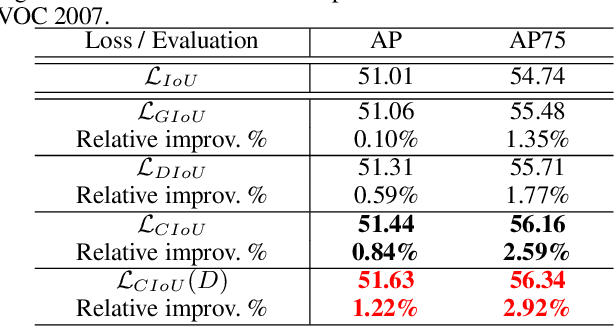
Abstract:Bounding box regression is the crucial step in object detection. In existing methods, while $\ell_n$-norm loss is widely adopted for bounding box regression, it is not tailored to the evaluation metric, i.e., Intersection over Union (IoU). Recently, IoU loss and generalized IoU (GIoU) loss have been proposed to benefit the IoU metric, but still suffer from the problems of slow convergence and inaccurate regression. In this paper, we propose a Distance-IoU (DIoU) loss by incorporating the normalized distance between the predicted box and the target box, which converges much faster in training than IoU and GIoU losses. Furthermore, this paper summarizes three geometric factors in bounding box regression, \ie, overlap area, central point distance and aspect ratio, based on which a Complete IoU (CIoU) loss is proposed, thereby leading to faster convergence and better performance. By incorporating DIoU and CIoU losses into state-of-the-art object detection algorithms, e.g., YOLO v3, SSD and Faster RCNN, we achieve notable performance gains in terms of not only IoU metric but also GIoU metric. Moreover, DIoU can be easily adopted into non-maximum suppression (NMS) to act as the criterion, further boosting performance improvement. The source code and trained models are available at https://github.com/Zzh-tju/DIoU.
 Add to Chrome
Add to Chrome Add to Firefox
Add to Firefox Add to Edge
Add to Edge